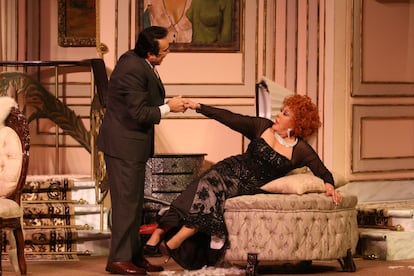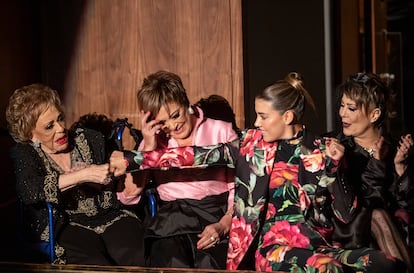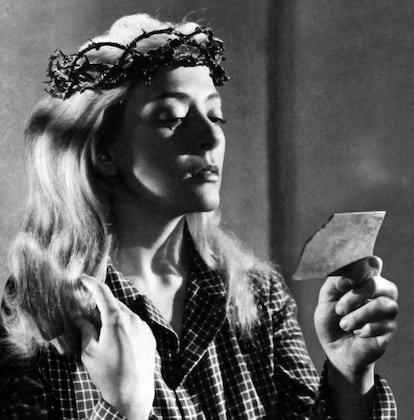Silvia Pinal, the last great diva of the era of Mexican golden cinema, who triumphed on the big screen with the help of Spanish director Luis Buñuel and was a long-time theater actress, soap opera actress and television presenter, died in Ciudad de Mexico this Thursday. Pinal was 93 years old. With it a myth of cinema dies, but also an era of splendor for an industry that struggles to survive amid public cuts to the arts and competition from new technological platforms. Pinal, one of the first actresses to do a nude in the cinema and break all the canons, celebrated her 93 years in style last September, when she stated that she felt “like an 18 year old” and that she was not afraid of death. .
Silvia Pinal (Mexico City, 1931) began her film career from a very young age, when she debuted in 1949 in the film Laura’s sin under the direction of one of the great filmmakers of the time, the Mexican Julián Soler, a member of an influential dynasty of actors in Mexico. Although that was a secondary role, it helped her break through in an industry in which the great male actors were the ones who set the standards for performances: they had the power to choose their co-stars and Pinal on several occasions confronted that kind of adversity to prove her worth as an actress. His name grew in the industry in the fifties of the last century, to the point of getting his first Ariel award, the recognition of Mexican cinema, for his performance in A corner near the sky (1952), directed by Rogelio González and starring the Mexican actor and singer Pedro Infante, who already enjoyed great international fame.
Pinal’s life, however, took a turn when the actor Francisco Rabal introduced her to the Spanish filmmaker Luis Buñuel, with whom she would work on three films that would give her worldwide fame to such an extent that she even claimed that she was the Spaniard’s “muse.” . This is how Pinal told that first meeting with Buñuel. “He didn’t take us very seriously. The first thing she asked me in front of Gustavo Alatriste (businessman and film producer to whom she was married) is: “Who is this man?” I told him he was my husband. “And why do you want to make movies with me?” he told me. “Because he loves me, Don Luis.” “That’s a good reason,” he replied.
It was the sixties and Spain was immersed in the blackness of the Franco dictatorship, with its national Catholicism and censorship. Religion had an enormous weight in this censorship, as Ricardo Pérez Montfort tells in his book Gunshots, silver and celluloid. History, cinema and photography in Mexico (Debate): “The Catholic religion was a principle without which Spain itself was inconceivable, but through evangelization, Hispanism stated that the Iberian Peninsula had ‘given meaning to the American peoples’… This Hispanism considered to Spain as the religious guide of the Latin American peoples.” Pinal and Alatriste convinced the great Spanish director, who had left his country due to the Franco uprising, to film Viridianapromising financing: “Buñuel was not a good merchant and did not charge much. Gustavo wrote him the checks. If he wanted 15, Gustavo would pay him 30. That fascinated the old man because he had never worked like that. “It was a total seduction,” the actress said in an interview with this newspaper for the publication of her book. This is me (Editorial Porrúa, 2015).
The film was shot in Spain with Silvia Pinal in the main character of the novice who must pass several tests before surrendering to the faith. The film is now revered as one of the great masterpieces of cinema, but at the time it was a scandal of apocalyptic magnitudes. The Church despised it, the Vatican attacked it as blasphemous and denounced Buñuel and the Franco regime banned it to the point of demanding that it be burned for, supposedly, being a veiled mockery of the so famous, in Franco times, of Christian piety. It was Pinal herself who saved Buñuel’s film from the flames of Catholic fanaticism and the wrath of the dictatorship, by secretly taking it to Mexico. This is what he said in 2016: “I had some copies in my suitcase. At customs a man asked me: “What are you bringing there?” My legs were shaking, but I told him they were some homemade short films I had filmed. This is how the film could be seen in Mexico. Nobody wanted to show it, but Salvador Novo helped us get cinema.”
Mexico had broken relations with Franco’s Spain after its victory in the Spanish civil war and welcomed tens of thousands of republicans and refugees whose presence in Mexican territory, Pérez Montfort affirms, gave ideological and cultural strength to the artistic, literary, scientists and politicians of the country. Despite this, there were conservative groups that also tried to boycott the presentation of the film, which won the Palme d’Or at the Cannes Festival. After Viridiana, Silvia Pinal filmed two other films with Buñuel: The exterminating angel (1962), considered one of the Spanish director’s masterpieces; and Simon of the desert (1964). In the 2016 interview with this newspaper, Pinal said: “To say that I am Buñuel’s muse seems too bold for me, but yes. I’m the only one who made three movies with him. Neither Catherine Deneuve nor Jeanne Moreau, nor anyone.” He said of the Spanish director that when filming he was “very strict, very exact. “There was no time for laughter or anything.” And he added: “Don Luis was only one and there is nothing to do. He was a great director and writer. What he did cannot be improved.”
Pinal accompanied the great actors of the time on the screen, Pedro Infante, Germán Valdés Tin TanGabriel Figueroa and Emilio The Indian Fernández. He also recorded films in Europe, mainly in Spain and Italy and had international recognition for his work, although he did not shine in Hollywood, but he claimed not to have regretted it. “At the time, a person came who was doing the musical Bells are Ringing in the United States. He told me to go study there, that he would pay for my school and expenses. I didn’t like the idea. Here she was already famous and had awards. Starting there didn’t matter or interest me,” he explained.

In addition to cinema and theater, La Pinalas they called her in Mexico, also ventured into politics. Her last husband was the politician and governor of the State of Tlaxcala Tulio Hernández Gómez, whom she married in 1982 and divorced in 1995. With him she entered the ranks of the PRI, the party that governed the country with an iron fist for more than seven decades and of whom he said “to be faithful until death.” The actress managed to be a deputy in the presidency of Carlos Salinas de Gortari, in 1991. “Being a deputy is the most beautiful position that someone can have. You can invent, create, be in the History of your country. It is a way to help, something that as an actress I cannot do,” she said.
After leaving politics, Pinal dedicated himself to television. She starred in soap operas produced by Televisa, the large Mexican network, which catapulted her into millions of homes in Latin America. In that company, which has had great power and political influence in the history of the North American country, the actress also produced and presented the program for 20 years Woman, real life caseswhich achieved enormous fame in Mexico. “I was a pioneer of television. I started in the wineries of Newswhere channel 4 started and I continued there. I love Televisa, it is my home. I thank God that it exists,” he said in the 2016 interview. It is said that Pinal had an affair with Emilio Azcárraga, owner of the television station. “I loved him a lot and he loved me a lot,” she said. “Until the last moment we were close friends,” said the diva, who was portrayed by Diego Rivera. The painting hangs on the walls of his house in El Pedregal, a wealthy neighborhood in the south of Mexico City.

Silvia Pinal, who was married four times (to the actor and director Rafael Banquells, the businessman and film producer Gustavo Alatriste, the singer and actor Enrique Guzmán and the PRI member Tulio Hernández Gómez) is survived by her children: Sylvia, the singer Alejandra Guzmán and Luis Enrique, the heirs of the actress’s legacy, valued, according to gossip magazines, at more than a billion pesos, including jewelry, properties, works of art and the theater. which bears his name in the Mexican capital. Pinal’s health went into crisis in December 2023, when she was hospitalized in intensive care. Her daughter Alejandra said on that occasion that the interpreter suffered a case of pneumonia from which she managed to recover satisfactorily. Pinal had been hospitalized in 2021 after suffering from a cardiac arrhythmia and testing positive for Covid 19. The artist remained hospitalized for several days for observation. Despite her fragile health, Silvia Pinal seemed to play with death until it knocked on her door. La Viridiana de Buñuel stated at her 94th birthday party: “Death does not scare me. “I feel like I’m 18.”
The people of Mexico adored her and in August 2022 she received a tribute at the Palace of Fine Arts, about to turn 92 years old. “Talking about you is talking about an artist who has been a pioneer of cinema, theater and television in our country,” said actress Diana Bracho that night. “A woman,” he added, “who assumed being an actress since she discovered the condition of her being.” It was a moving evening, to which Pinal arrived in a wheelchair. From the audience, while she was on stage, a shout rang out from the audience: “Silvia!” “What?” she responded. “We love you,” the voice said. And the theater thundered with applause.

